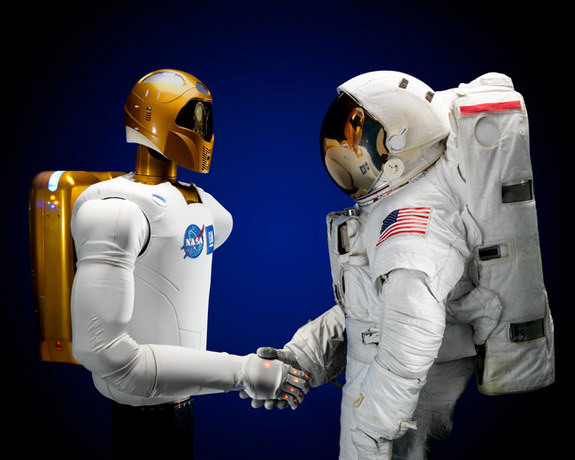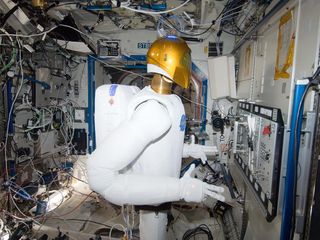Hey Coders! NASA Wants You to Help Robot Astronaut See

NASA is asking software coders on Earth to help a robotic astronaut helper on the International Space Station use its cold mechanical eyes to see better.
Robonaut 2 — a humanoid robot being tested by astronauts on the space station — is designed to perform mundane and complex tasks to help make life on the orbiting lab easier for human crewmembers. So far, the robot (which NASA affectionately calls R2 for short) has carried out a series of routine tasks on the space station, performed sign language and learned how to shake hands with human crewmates.
But NASA thinks the robot can do more and launched two new contests under the $10,000 Robonaut Challenge on Monday (April 1) to make it happen.
The new competitions, managed for NASA by the group TopCoder under the agency's NASA Tournament Lab, will give 470,000 software developers, digital creators and algorithmists the chance to help the robot butler "see" and interact with the station in a new way.

Each of the competitions will run for three weeks, and $10,000 in prize money will be awarded. As of this article's publication, 533 people have registered for the first competition, and 10 have submitted final algorithms. [Robonaut 2: NASA's Space Droid (Photos)]
"Do you think your code and your solutions can help advance humankind by advancing a humanoid kind?" a promotional video for the competition exclaims.
Contest participants in the two Robonaut competitions may eventually enable Robonaut 2 to better perform "repetitive, monotonous tasks" so that astronauts won't have to, according to a statement issued by TopCoder.
Get the Space.com Newsletter
Breaking space news, the latest updates on rocket launches, skywatching events and more!
Robonaut vision showdown
The first contest involves writing an algorithm that will make Robonaut 2 locate and understand whether buttons and switches on a dashboard are turned off or on. NASA has provided images of the boards on the station, in a laboratory and in a simulator. Every setting has a different set of circumstances that the robot would need to work within.
"The successful algorithm application must work with each of several different camera systems and varying lighting conditions within each environment," TopCoder officials said.
The second competition builds on the first. Using the algorithm created during the first contest, competitors need to write more code that actually controls the motions of Robonaut 2's hands.
"The algorithm will need to 'see' an object, recognize it, and correctly operate and interact with it in the most efficient and safe manner possible," TopCoder officials wrote.
The $2.5 million Robonaut 2 weighs about 330 pounds (149 kilograms) and consists of a torso, arms and heads. From head to base, the robot is about 3 feet, 4 inches (1 meter) tall.
NASA launched Robonaut 2 to the International Space Station in 2011 during the final flight of the space shuttle Discovery.
NASA's space station contests
The Robonaut Challenge is the latest in a series of space station contests by NASA and TopCoder to foster innovation in space technology and spaceflight.
Together, NASA and TopCoder have conducted a $30,000 Longeron contest for software designed to help the space station maximize power from its solar arrays; a $24,000 Space Med Kit competition for a new algorithm for space medical monitoring; and the $13,000 Planetary Data System Idea Challenge (PDS) to a new way to search from NASA's more than 100 terabytes of space image and data from 30 years of planetary missions.
TopCoder has also completed competitions for an International Space Station Food Intake Tracker (ISS-FIT) iPad App, which is aimed at tracking dietary needs of astronauts, and a Voice Command Idea Generation project.
"We feel that our collective efforts on Robonaut 2, along with our successful Longeron, PDS and FIT programs have exposed the exciting prospect that game changing solutions can be created at reasonable cost by a new generation of engineers, programmers and technologists which is critical to innovation in the public sector and beyond," TopCoder President Rob Hughes said.
For more information on NASA and TopCoder's Robonaut Challenge visit the competition page on TopCoder.com.
Follow Miriam Kramer @mirikramer and Google+. Follow us @Spacedotcom, Facebook and Google+. Original article on SPACE.com.
Join our Space Forums to keep talking space on the latest missions, night sky and more! And if you have a news tip, correction or comment, let us know at: community@space.com.

Miriam Kramer joined Space.com as a Staff Writer in December 2012. Since then, she has floated in weightlessness on a zero-gravity flight, felt the pull of 4-Gs in a trainer aircraft and watched rockets soar into space from Florida and Virginia. She also served as Space.com's lead space entertainment reporter, and enjoys all aspects of space news, astronomy and commercial spaceflight. Miriam has also presented space stories during live interviews with Fox News and other TV and radio outlets. She originally hails from Knoxville, Tennessee where she and her family would take trips to dark spots on the outskirts of town to watch meteor showers every year. She loves to travel and one day hopes to see the northern lights in person. Miriam is currently a space reporter with Axios, writing the Axios Space newsletter. You can follow Miriam on Twitter.